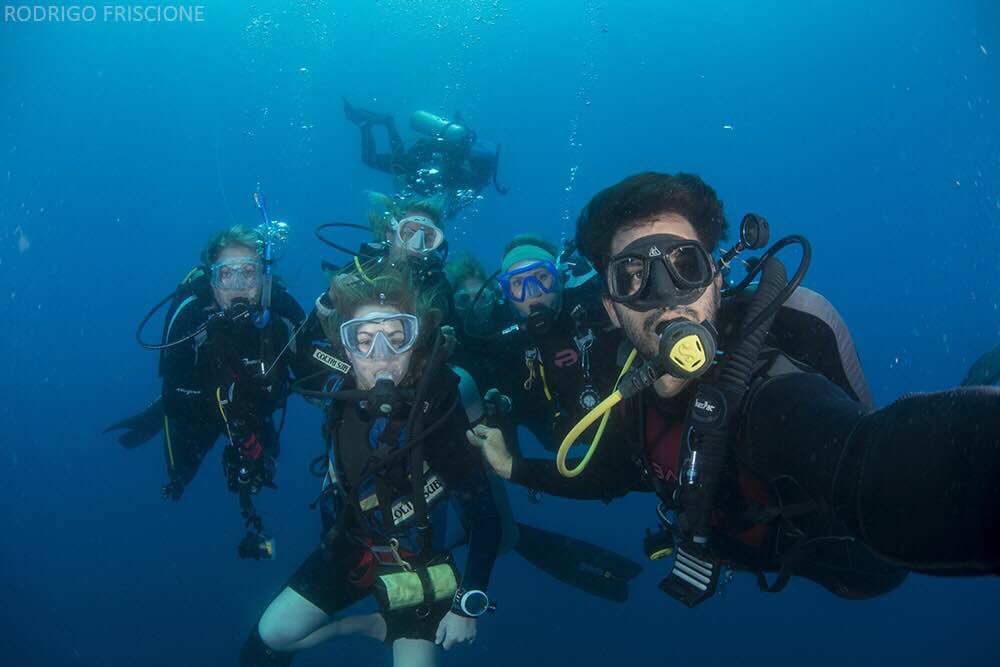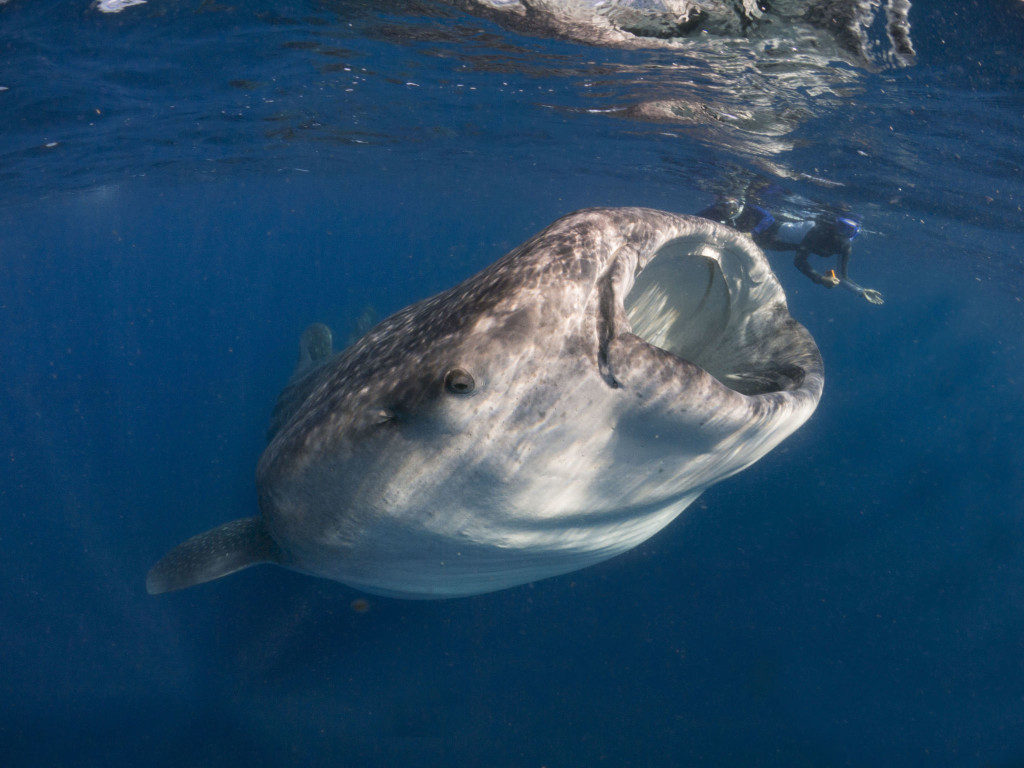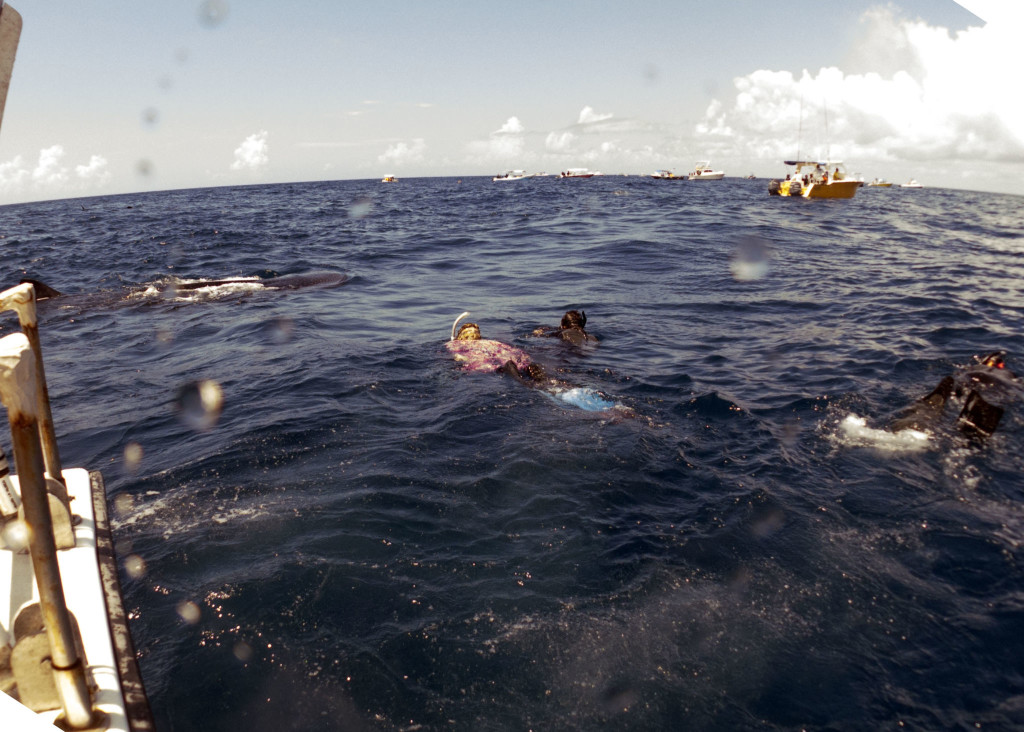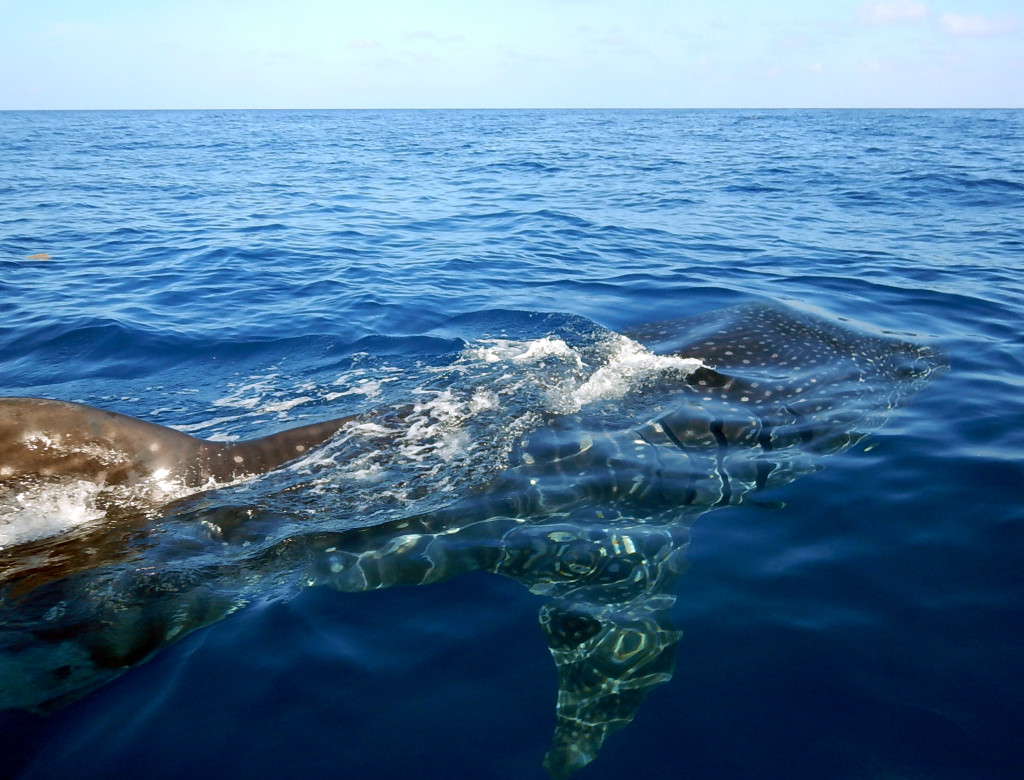Marine Life & Conservation
Citizen Science with Marine Megafauna Foundation

The Marine Megafauna Foundation Ray of Hope Expedition 2015 included a marine biologist (USA), a geneticist (Japan, living and working in the US), a biologist from the Maldives (a Scot by birth), a scuba instructor from the Maldives (a Kiwi), a Penn biology major (from Mexico), a videographer (South Africa), and those of us, scuba divers and/or photographers, who care deeply about our watery world, both Canadian and US. Our mission was to photograph animals (Whale Sharks and Manta Rays) for Identification, upload to Whaleshark.org and MantaMatcher.org, and to take genetic samples from the Manta Rays of the Yucatan. We were not entirely successful with the Mantas…the elusive creatures… well, they eluded us! We did manage to get 7 or so, but we fell far short of the desired 30 samples.
Whale Sharks, on the other hand, were in abundance. The Yucatan is one of the world’s largest aggregations of whale sharks, if not the largest. We headed out in the mornings for a 90 minute boat ride to the shark area, typically just before sunrise, and seeing the dawn out on the calm Caribbean Sea was a serenely beautiful experience. Once out to the shark area (wherever the whale sharks are gathering and feeding that particular day) it became disheartening to see all the tourist boats. There must have been 50 boats on some days.
Please do not get me wrong. We are trying to conserve and preserve these animals by showing how valuable they are to tourism, and valuable they certainly are. Tourists are out in droves to see and to swim with them. 40 or 50 boats at a time can seem pretty excessive, though. The first day we hung out on the edges, swimming with the sharks who were on the periphery of the tourists. We were on a scientific vessel and had a permit to be in the water with them for study. The first day was very shark rich, and I was able to get several ID shots, as did other members of the group. The best day was ahead, however.
On the third day of the expedition we headed out looking for mantas, and skipped the whale sharks until around noon. By that time, the boats were gone. We had 30 or so whale sharks to ourselves, and one other boat. It had to have been one of the best animal encounters I have ever had. Without the hoard of boats, one could be patient, waiting for feeding whale sharks to swim by. We didn’t have to chase them, or even swim that hard to stay up with them (they may look as though they are moving slow, but they are really going much faster than you think) because they were lazily filtering the surface of the water, knowing they were pretty much alone and in no hurry. With several boats, it gets confusing, and the sharks often have to change course to avoid snorkelers, but on this day, they were content and feeding happily on tuna spawn. Every time we got out of the water we had to brush off tuna eggs from our wetsuits and hair.
I have not been happy with the whale shot photographs I have taken over the years. On this glorious day, alone with whale sharks, I took the best photographs I have ever taken of these spotted, gentle giants. Just incredible!
My dream has always been to watch a whale shark vertically feeding in the water, and to capture photos of it. My dream came true with a huge, pregnant Whale Shark who had to be 40 feet long. She was immense, and it was amazing to watch her, vertical and still, while she filtered tuna spawn. Ah, she was such a beauty! And lucky for me, Dr Andrea Marshall (the Director of Marine Megafauna Foundation and Ray of Hope) was in the water and captured an incredible, once in a lifetime photo of me with the whale shark. Yes, I will be framing it! I can’t tell you how thrilling it is to have a photo of this quality! Thank you, Andrea!
I took several ID photos and uploaded them to www.whaleshark.org. It was exciting to receive a few matches, telling me that I had photographed a shark who had been photographed several times over the past 5 years. It’s also exciting NOT to receive matches, meaning I uploaded photos of sharks who were new to the system. I am thrilled to be able to assist conservation science by being a Citizen Scientist.
“In today’s world, it’s clear that our natural environment cannot be preserved and protected by the few people officially designated with this task. It will take all of us, in all parts of the world. We all need to find ways to help in this monumental task.
Citizen Science offers each of us a path to find special ways in which we can each help protect our part of the world. It’s an elegant, efficient, and engaging solution to the huge environmental problems we face in the 21st century.” www.citizenscientists.com
I cannot begin to express the wonder and the thrill of being near to these ocean pelagics. It is truly awe-inspiring… and I am so grateful I can help in their conservation. Check out http://www.citizenscientists.com/ and check out how many ways there are to help!
For more from Tam, visit www.travelswithtam.com.
Marine Life & Conservation
Paul Watson Released as Denmark Blocks Japan’s Extradition Bid

Renowned anti-whaling activist Paul Watson has been released from custody in Greenland after spending five months in detention. Denmark’s Justice Ministry rejected Japan’s request for his extradition, citing insufficient guarantees that his time already served in custody would be credited against any potential sentence.
The 74-year-old Canadian-American was arrested on July 21 in Nuuk, Greenland’s capital, when his ship docked to refuel. His arrest was based on a 2012 Japanese warrant related to a 2010 encounter in Antarctic waters. Japan alleged Watson obstructed operations and caused damage to a whaling research ship during efforts to disrupt illegal whaling. Watson has consistently denied these claims, maintaining his commitment to marine conservation.
Denmark, which oversees extradition matters for Greenland, concluded that while the legal conditions for extradition were met, the lack of assurances from Japan regarding time-served credit made extradition untenable.
In a video shared by his foundation, Watson expressed gratitude and relief, saying, “After five months, it’s good to be out… and good to know they’re not sending me to Japan.” He added that the most difficult part of his time in custody was being separated from his two young sons.
Watson is a pioneering figure in marine conservation, known for founding the Captain Paul Watson Foundation in 2022 after decades of activism with the Sea Shepherd Conservation Society. His bold efforts to defend marine life have earned him widespread support, including from celebrities and conservationists. His work has also been featured in the acclaimed reality TV series Whale Wars.
Watson’s lawyer, Jonas Christoffersen, praised the decision, stating, “We are happy and relieved that Paul Watson is now free.” He added that Watson is eager to reunite with his family and continue his vital work.
The arrest occurred while Watson’s vessel, the M/Y John Paul DeJoria, was en route to the North Pacific with a team of 26 volunteers to intercept a Japanese whaling ship. His foundation described the arrest as politically motivated and emphasized that Watson’s actions were focused on ending illegal whaling practices.
Japan resumed commercial whaling in 2019 after leaving the International Whaling Commission, asserting that whale meat is a cultural tradition. Conservationists, however, continue to challenge these practices, highlighting their impact on marine ecosystems.
Despite the challenges, Watson remains steadfast in his mission to protect marine life and bring attention to whaling practices. His dedication to ocean conservation has made him a globally respected advocate for the environment.
Marine Life & Conservation
12 Days of Zero-Waste Fish-mas

This holiday period, the Marine Conservation Society, the UK’s leading ocean membership charity, invites you to make some simple changes to eating fish this Christmas to help our seas.
Dr Kenneth Bodles, Head of Fisheries and Aquaculture at the Marine Conservation Society, said, “During the festive season, our consumption increases, but so does waste. Sustainability isn’t just about where food comes from – it’s also about how you use it. By reducing waste and making the most out of your seafood, you’re not only taking steps to be more ocean-friendly, but can also help to cut costs during what is often one of the most expensive times of the year”.
The Marine Conservation Society has compiled twelve tips on how to consume seafood sustainably with zero-waste this Christmas:
Buy whole fish instead of fillets
Instead of fillets, consider buying whole fish such as salmon, hake, or lemon sole. By adopting a “nose to tail” approach with cooking, whole-baked fish not only feeds a crowd, but also helps to minimise waste and maximise sustainability by using up every part of the animal, including bones, skin, and fat.
Make fish stock
Leftover fish bones or shells can be put to good use by boiling them to make a nourishing fish stock or bisque. This can be frozen and preserved for later use and makes for a flavourful base in a soup.
Make your own fish pâté
Avoid waste by turning leftover fish, such as smoked mackerel or salmon, into a delicious pâté by blending with cream cheese and lemon. Perfect when paired with crackers.
The sustainability of salmon and mackerel varies depending on where and how it is caught or farmed. For more information on green-rated options, check the charity’s Good Fish Guide.
Buy frozen
By purchasing seafood that is frozen or vacuum-packed, this helps to reduce waste by extending the shelf life of your food.
Fish pie
If you’re wondering what to do with leftover cooked fish, why not opt for a classic fish pie with mashed potatoes, leeks, and a cheesy sauce? A sure crowd pleaser on Boxing Day.
Use the head
Don’t forget the fish head! The meat is incredibly tender and flavourful. The charity recommends a cod’s head curry or recreating Fallow’s renowned cod’s head in siracha butter.
By stretching your ingredients further, not only is this a more sustainable way to enjoy seafood, but also cost-effective by repurposing leftovers and cooking creatively.
Boxing Day brunch
Mix leftover kippers or smoked salmon with scrambled eggs for a tasty, zero-waste, Boxing Day brunch.
For best choice, make sure you buy kippers, or herring, from the North Sea and the North Irish Sea.
Zero-waste storage
A top tip from the Marine Conservation Society to avoid waste is freezing fish offcuts to save for future use.
Crisp up the skin
Even leftover fish skin can be turned into a quick savoury snack by crisping it up in an air fryer with a little olive oil and salt.
Anchovies two ways
Leftover anchovies can either be blended with butter to make a delicious anchovy butter or tossed into pasta for a hit of umami flavour.
The charity recommends opting for anchovies caught in the Bay of Biscay for best choice.
Fishcakes
For an easy, zero-waste meal, leftover seafood trimmings can be mixed with mash and fried in breadcrumbs to make fishcakes.
Pickled mussels
Try pickling mussels in 1:1 vinegar and water, with a dash of sugar for a sustainable, zero-waste snack that can be enjoyed well beyond the festive season.
Mussels farmed in the UK are a seafood superhero. Grown using low-impact methods and harvested by hand, they get all the food they need from the sea around them. This makes them one of the most sustainable, ocean-friendly, and cost-effective seafood options.
Players of People’s Postcode Lottery have raised £6.6M towards the Marine Conservation Society’s vital work in making seafood more sustainable.
Laura Chow, Head of Charities at People’s Postcode Lottery, said: “Fish is a festive favourite for many, but making sustainable choices when it comes to how we buy and eat seafood makes all the difference for our ocean. Support from players of People’s Postcode Lottery has helped the Marine Conservation Society further its sustainable seafood work, so that we can all enjoy healthier, better protected seas.”
The Marine Conservation Society encourages you to make sustainable seafood choices a year-round habit, not just for Christmas. To check how sustainable the seafood on your plate is, you can visit the charity’s Good Fish Guide. The Guide helps consumers and businesses identify the most sustainable seafood using a simple traffic light system, based on where and how species are caught or farmed. Green is the best choice, amber means improvements are needed, and red indicates fish to avoid buying.
Zero-waste gift idea
Why not embrace a zero-waste Christmas by gifting a membership to support marine conservation? It’s a meaningful, low-waste gift that helps protect our ocean for generations to come. Memberships start from as little as £5 a month – the price of a sandwich and drink from your local coffee shop.
Find the latest sustainable seafood advice for wild-caught and farmed seafood on the Good Fish Guide, downloadable to your phone from www.mcsuk.org/goodfishguide.
-

 News2 months ago
News2 months agoIconic SS United States to become the World’s Largest Artificial Reef
-

 News3 months ago
News3 months agoBook Review – 52 Assignments: Underwater Photography
-

 Gear News3 months ago
Gear News3 months agoDYNAMICNORD – New German diving brand enters the British market
-

 News3 months ago
News3 months agoExploring Cenote El Pit: A Diver’s Dream
-

 Gear News3 months ago
Gear News3 months agoTry BARE drysuits (and maybe even win one!) this Friday with Sea & Sea at North West Dive Fest
-

 Marine Life & Conservation3 months ago
Marine Life & Conservation3 months agoBook Review: Coral Triangle Cameos
-

 Blogs2 months ago
Blogs2 months agoDive the Egyptian Red Sea this Autumn with Regaldive
-

 News3 months ago
News3 months ago2024 Ocean Art Underwater Photo Competition Announced








